Our technological world has transformed drastically in recent history, and our understanding of the biological effects of these electromagnetic frequencies continues to grow. It is becoming increasingly clear that our technology is hurting us. When moving towards a healthier home, identifying sources of man-made electromagnetic radiation and assessing your EMF exposure level is a key component to health. This is especially important with the ever-increasing proliferation of wireless technology in our lives. For further information on the harmful effects of EMF exposure check out my video here.
Wireless devices emit frequencies which fall into the “microwaves” section of the electromagnetic spectrum (yep, same as your microwave). However, this makes up only one part of a home’s EMF status. Electric and magnetic fields, and geopathic stress are other areas of concern. This article will focus on the wireless sources of radiation in our living spaces; identifying them and offering tips on how to keep you and your family safe. When assessing your home’s EMF levels, the best approaches would be to buy an introductory meter and teach yourself to test, or best case, hire a professional to test for you. However, there are many things you can do to significantly lower your exposure levels right now.
Common Sources of EMF Exposure
Cell Phones
6 out of 7 billion people in the world have a cell phone, while only 4.5 billion have access to a proper toilet (link). It’s impressive how quickly this technology has been embraced and turned into a “necessity” for most of us. However, education and knowledge on how to safely use these devices has not kept pace with current research. Changing some daily practices can significantly lower your exposure. Check here to read your phone’s fine-print regarding RF (radiofrequency radiation) exposure. Usually carrying it in your pocket or holding it next to your ear, exceeds safety levels (which haven’t been updated since 1996 and are seriously questionable).
Turn on airplane mode as often as you can (ensure that bluetooth and Wi-Fi are off too), this is especially important when you are carrying it next to your body. Check here for instructions on putting an Android phone on airplane mode.
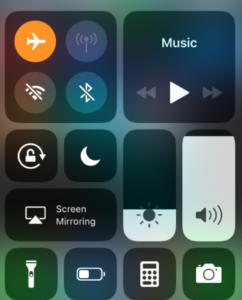
Special care should be taken when using mobile phones and tablets around children. Children should not be holding phones or tablets, unless they are on airplane mode, and especially not during a call or streaming video, as radiation is significantly higher during these times.
You can also use an EMF blocking blanket (woven with silver thread) to protect certain areas of your body (option 1, option 2). These could be used when working on a computer, phone, tablet, etc. Using a blanket can be especially useful when protecting young children and babies. Belly Armor is a great website with options for Moms. Or you could always buy fabric yourself, from here, and make your own (enter code ‘TheHealthierHome for 5% discount).
Downloading games and apps that can be used offline (when in airplane mode) is a great strategy to reduce EMF exposure. Certain streaming services offer this, such as Spotify, Amazon Prime, Gaia and some Netflix titles. Even when reading articles, you can download the article and then switch to airplane mode while you are reading it. Any limit to exposure is beneficial to your health.
When your phone is on, leave it as far away from you as possible. You can also buy shielding devices (RadiaFence™ – click on Computer Shields) to put your phone (or other wireless devices) behind. These are essentially clear plastic frames with a fine metal mesh in them. They can do a good job of blocking a high percentage of the RF (radiofrequency) radiation, when used properly. They act as a screen, so as long as you keep the screen in between yourself and the phone, for example, they can be a great tool (see picture with baby monitor below).
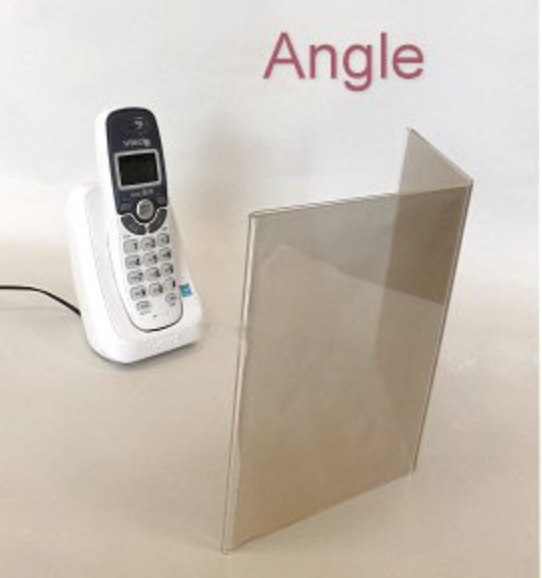
Use Speakerphone when making calls and ensure the phone is out of your hands. Distance is your friend, as radiation diminishes significantly the further away you are from the source. When you’re texting hold the phone away from your body when you press “send”. If you are downloading something wirelessly (video, webpage, song), put the phone down until it has finished downloading. You can also use the shielding device mentioned above to put the phone behind when you speaking. Again, the best option is always opting for a wired connection. Using a VoIP and your wired computer, is a cheaper and healthier way to use a phone.
There are great options for getting wired internet to phones and tablets too. The most direct option for iPhone / iPad would be an adapter like this or this. There are a few options around, just be sure to check that the adapter works with your version of phone or tablet and has good reviews. Instructions for wiring Android devices can be found here.
Wi-Fi Router
Wi-Fi routers are very high emitters of electromagnetic radiation. They are often made to emit stronger than necessary, greatly increasing EMF exposure (I can pick up the Wi-Fi signal from a coffee shop that is 500 metres away). Measurements within a 10 foot radius easily measure into what is considered “extreme concern” according to Building Biology standards for sleeping areas. As you move closer to the source, electromagnetic radiation increases significantly. This reading was taken 3.5 feet away and shows a reading of 32,500 μW/m2, which falls well into the “extreme concern” category (greater than 1000 μW/m2) according to Building Biology standards for sleeping areas.
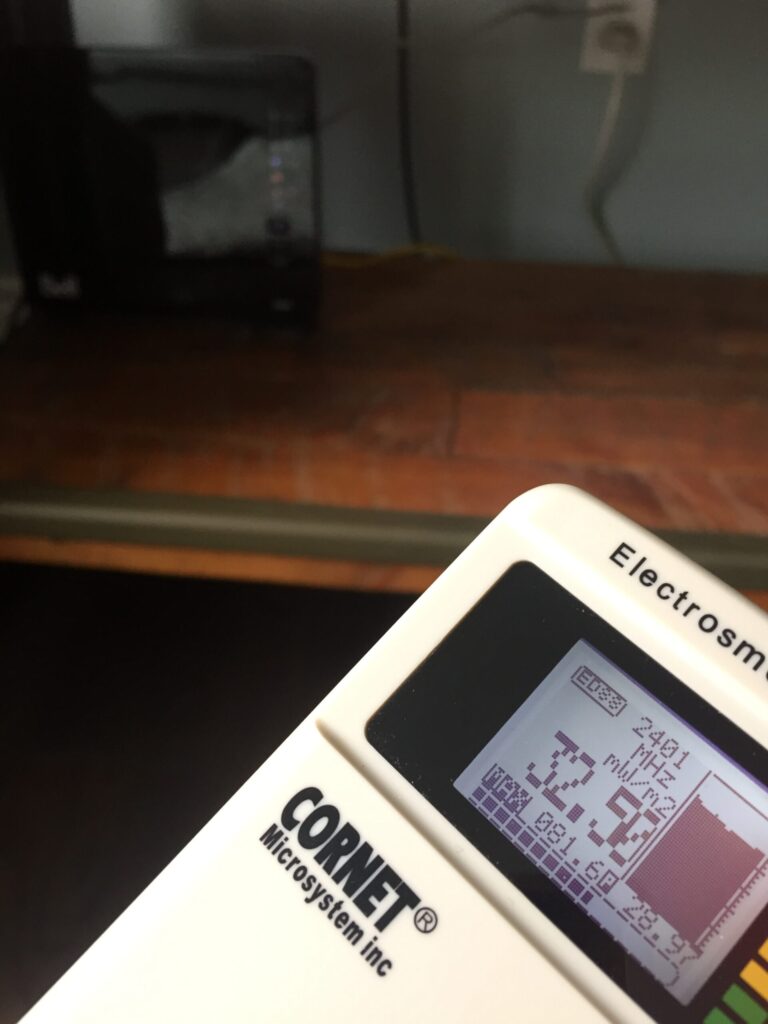
There are different options you can take to limit the exposure to your router. When going to bed at night, turning off your router is an easy and effective way to decrease your exposure. Creating the healthiest environment possible at night is especially important to allow your body to rejuvinate and heal. An easy way to ensure you don’t forget this is to plug your router into a timer switch (like this one) and have it turn off automatically during the night.
Another option is to opt for a router that doesn’t emit radiation constantly. These routers are a better option, as they significantly reduce radiation levels. They do this by reducing the power and pulse frequency, while offering other options such as a button to easily disable/enable Wi-Fi. Similar options are available here.
There are also cages that can be placed around your router to reduce their radiation. The WaveCage™ can be purchased from here, or a similar cage can be bought from here. They can have a good effect in reducing radiation levels (see comparison readings below).
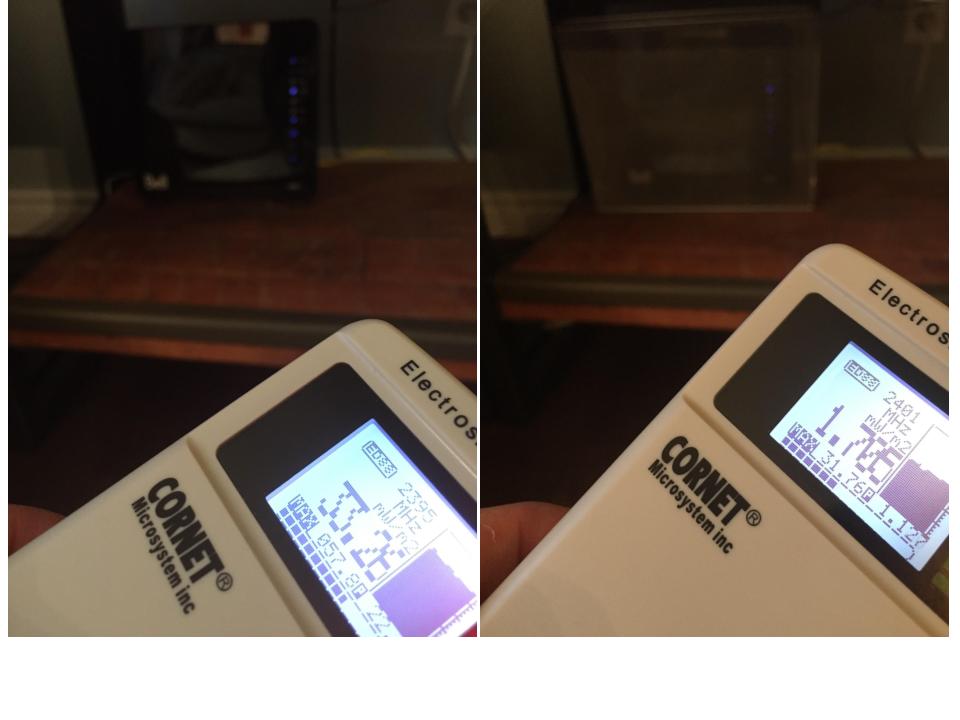
The healthiest option is to get back to the wired world and there are some great options now available for this. You can always string a bunch of wires and tuck them out of sight, or use these D-Link PowerLine Adapters to turn your home’s electrical wiring into a network connection. You simply plug your router into an adapter using an Ethernet cable, and then any outlet you plug another PowerLine Adapter into will be live with internet, ready for a wired connection. There is a similar option called MoCA, which uses the existing coaxial (TV) cables in your home.
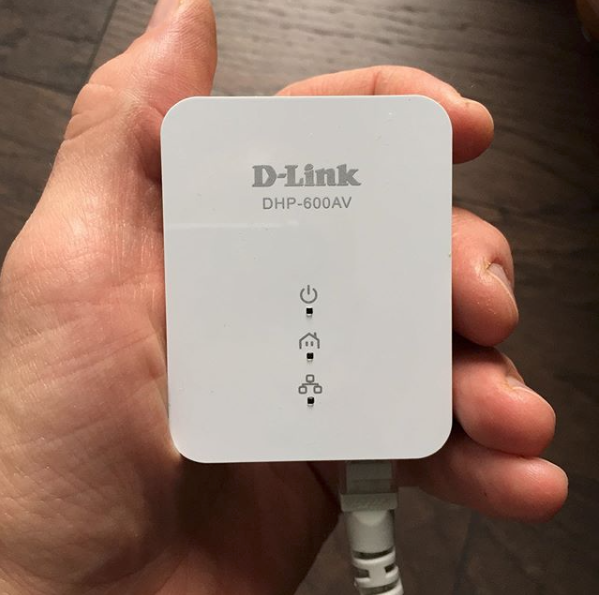
Once you have set up your wired connection, its important to ensure that the Wi-Fi is turned off on your router. This will be slightly different depending on your specific router. It involves connecting a computer to your router with an ethernet cord, typing in a specific ip address (ex: 192.168.1.1) and then a menu will load where you can switch off Wi-Fi. The best approach is to search for specific instructions by typing your internet service provider’s name and the make and model of your router into a search engine. If this doesn’t work, you can call your internet provider’s technical support and they will guide you through it.
Laptops and Tablets
Laptops and tablets are not designed to be used on your lap. Laptops are usually tested 20cm away from the body, and other devices (tablets, phones, video game systems, Google Home, etc), all have different recommended distances they should be kept from the body (even when based on outdated safety standards). More information on wireless devices and distance recommendations can be found here. Wired connections are always your healthier choice, but there are other shielding options available, which can lessen the impact on your body.
DefenderShield and SafeSleeve both offer good options for flat shields that can be used to put the laptop or tablet on. Keeping this shield between yourself and the device (laptop, tablet), will lessen the amount of radiation your body is being exposed to. There is also an option from HaraPad that provides additional protection by slightly contouring around the front of the laptop. Using a wired connection for you laptop, and disabling the Wi-Fi is a healthier option. There are also ways to get wired internet to your tablet (instructions for iPhone/iPad are above). Here are instructions for wiring Android devices.
Baby Monitors
Baby monitors emit an impressively large amount of electromagnetic radiation. This is especially concerning because these devices are put in close proximity to babies and adults while sleeping. The younger you are, the more susceptible your body is to wireless radiation (Links 1, 2, 3).
There are a few options when looking for a healthier baby monitor solution. One option would be using the RadiaFence™ shield, as discussed above. You could place the monitor and parent unit behind these shields to lower the amount of radiation you’re being exposed to (see measurement below).
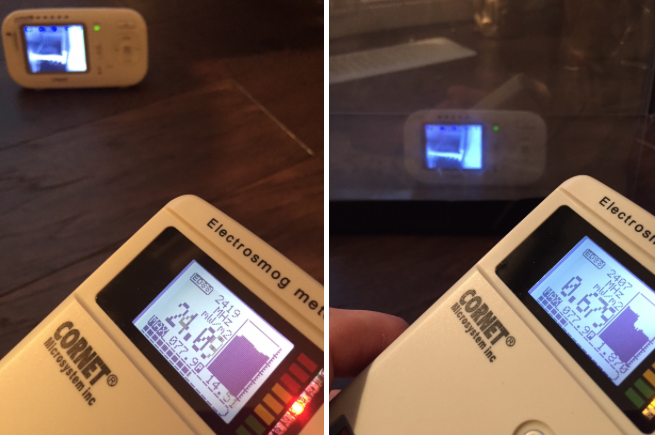
The healthiest option would be opting for a wired monitor. This can be accomplished, with a little effort. The first step is purchasing a camera that can handle a wired connection (option 1, option 2). Then setting up a wired connection in your house, using the D-Link PowerLine adapters mentioned above. There’s a great post here from TechWellness that goes into more detail on the specifics of accomplishing this.
Other Wireless Sources of EMF Exposure
- Cordless phones (especially the base station)
- Video game systems
- TV’s
- Wi-Fi thermostats
- Any “smart” devices, including “smart” utility meters – Take Back Your Power is an award-winning documentary on “smart meters” and their issues, highly recommended.
- Microwave ovens
- Wireless toys (many use the same frequency as your WiFi router)
- Bluetooth speakers and other devices
Remember that increasing your distance from the source can make a big difference. Radiation levels increase significantly the closer you are to the device (cell phone, Wi-Fi router, baby monitor, cordless phone). Increasing distance is good, including shielding (with testing) is better, and going for a wired solution is always the best.
To help your body deal with the effects of our electromagnetically charged world, try grounding. This is the practice of getting outside and walking barefoot or connecting physically to the Earth in another way (gardening with bare hands for example). This allows the Earth’s healing electrical charges to infuse your body. For more information on the benefits of grounding click here and here. Working to include frequent breaks outside, ideally to ground and get natural sunlight, will help your body deal with the cumulative effects of EMF exposure.
In becoming aware of our EMF exposure, and assessing our home’s current EMF status we can move towards levels which are more in line with nature. These lower levels are where we feel best and thrive. This would mean tackling the wireless issue, as focused on in this article. This is especially important due to its unabated advancement and proliferation in our lives, despite for example, 5G having no safety testing. Along with wireless radiation, however, there are also electric and magnetic fields, along with potential geopathic stress zones within a home. Understanding the EMF exposure status of your indoor environment is no small feat. The best way to adequately assess your home is through professional testing. However, remembering certain practices and implementing tweaks to your indoor environment can lead you towards healthier living spaces and noticeable increases in the quality of your health.


